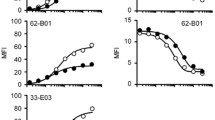Abstract
Chimeric T cell receptors (chTCRs), composed of the single-chain variable fragments (scFv) of murine antibodies and human signaling molecules, are used to redirect the specificity of autologous or allogeneic T lymphocytes. To develop novel therapeutic agents for treatment of chronic myeloid leukemia (CML), we engineered a scFv from the hybridoma cell line CMA1 which produces monoclonal antibody specific against CML. The genes encoding the heavy and light chain variable regions were amplified from CMA1 cDNA and a humanized chTCR was constructed. Expression of the novel hchTCR was verified in NIH3T3 cells transduced with retroviral vectors. The results demonstrated that hchTCR can be expressed and presented on cell surface normally. These results suggest that retroviral vectors expressing hchTCR specific for CML cells may be used to redirect human T lymphocytes.




Similar content being viewed by others
References
Dudley ME, Wunderlich JR, Shelton TE, Even J, Rosenberg SA (2003) Generation of tumor-infiltrating lymphocyte cultures for use in adoptive transfer therapy for melanoma patients. J Immunother 26(4):332–342
Eshhar Z, Waks T, Gross G, Schindler DG (1993) Specific activation and targeting of cytotoxic lymphocytes through chimeric single chains consisting of antibody-binding domains and the gamma or zeta subunits of the immunoglobulin and T-cell receptors. Proc Natl Acad Sci USA 90(2):720–724
Friedmann-Morvinski D, Bendavid A, Waks T, Schindler D, Eshhar Z (2005) Redirected primary T cells harboring a chimeric receptor require costimulation for their antigen-specific activation. Blood 105(8):3087–3093
Guilhot F, Roy L, Saulnier PJ, Guilhot J, Barra A, Gombert JM, Turhan A (2008) Immunotherapeutic approaches in chronic myelogenous leukemia. Leuk Lymphoma 49(4):629–634
Ho WY, Blattman JN, Dossett ML, Yee C, Greenberg PD (2003) Adoptive immunotherapy: engineering T cell responses as biologic weapons for tumor mass destruction. Cancer Cell 3(5):431–437
Hombach A, Wieczarkowiecz A, Marquardt T, Heuser C, Usai L, Pohl C, Seliger B, Abken H (2001) Tumor-specific T cell activation by recombinant immunoreceptors: CD3 zeta signaling and CD28 costimulation are simultaneously required for efficient IL-2 secretion and can be integrated into one combined CD28/CD3 zeta signaling receptor molecule. J Immunol 167(11):6123–6131
Maher J, Brentjens RJ, Gunset G, Riviere I, Sadelain M (2002) Human T-lymphocyte cytotoxicity and proliferation directed by a single chimeric TCRzeta/CD28 receptor. Nat Biotechnol 20(1):70–75
Mapara MY, Sykes M (2004) Tolerance and cancer: mechanisms of tumor evasion and strategies for breaking tolerance. J Clin Oncol 22(6):1136–1151
Marincola FM, Jaffee EM, Hicklin DJ, Ferrone S (2000) Escape of human solid tumors from T-cell recognition: molecular mechanisms and functional significance. Adv Immunol 74:181–273
Power BE, Caine JM, Burns JE, Shapira DR, Hattarki MK, Tahtis K, Lee FT, Smyth FE, Scott AM, Kortt AA, Hudson PJ (2001) Construction, expression and characterisation of a single-chain diabody derived from a humanised anti-Lewis Y cancer targeting antibody using a heat-inducible bacterial secretion vector. Cancer Immunol Immunother 50(5):241–250
Rezvani K, Yong AS, Mielke S, Savani BN, Musse L, Superata J, Jafarpour B, Boss C, Barrett AJ (2008) Leukemia-associated antigen-specific T-cell responses following combined PR1 and WT1 peptide vaccination in patients with myeloid malignancies. Blood 111(1):236–242
Rossig C, Brenner MK (2004) Genetic modification of T lymphocytes for adoptive immunotherapy. Mol Ther 10(1):5–18
Schmitt M, Li L, Giannopoulos K, Chen J, Brunner C, Barth T, Schmitt A, Wiesneth M, Dohner K, Dohner H, Greiner J (2006) Chronic myeloid leukemia cells express tumor-associated antigens eliciting specific CD8+ T-cell responses and are lacking costimulatory molecules. Exp Hematol 34(12):1709–1719
Willemsen RA, Weijtens ME, Ronteltap C, Eshhar Z, Gratama JW, Chames P, Bolhuis RL (2000) Grafting primary human T lymphocytes with cancer-specific chimeric single chain and two chain TCR. Gene Ther 7(16):1369–1377
Yee C (2005) Adoptive T cell therapy: addressing challenges in cancer immunotherapy. J Transl Med 3(1):17
Yotnda P, Firat H, Garcia-Pons F, Garcia Z, Gourru G, Vernant JP, Lemonnier FA, Leblond V, Langlade-Demoyen P (1998) Cytotoxic T cell response against the chimeric p210 BCR-ABL protein in patients with chronic myelogenous leukemia. J Clin Invest 101(10):2290–2296
Acknowledgments
This work was supported in part by research grants from the National Science Foundation of China Grants No. 30871102 to Wenli Feng and the Doctor Foundation of Chongqing Medical University 2008 to Dong Wang. The authors declared no competing interests. We thank Prof. Tong-chuan He, the director of the Molecular Oncology Laboratory of the University of Chicago Medical Center in America, for critical reading of the manuscript.
Author information
Authors and Affiliations
Corresponding author
Additional information
Dong Wang and Lijun Zhang are contributed equally to this work.
Electronic supplementary material
Below is the link to the electronic supplementary material.
Rights and permissions
About this article
Cite this article
Wang, D., Zhang, L., Li, Y. et al. Construction and expression of humanized chimeric T cell receptor specific for chronic myeloid leukemia cells. Biotechnol Lett 34, 1193–1201 (2012). https://doi.org/10.1007/s10529-012-0896-5
Received:
Accepted:
Published:
Issue Date:
DOI: https://doi.org/10.1007/s10529-012-0896-5




